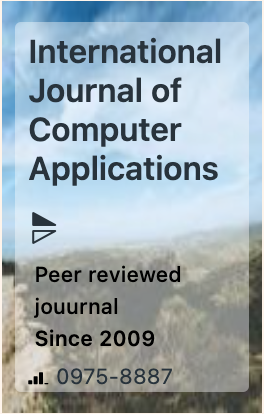The week's pick
Random Articles
Reseach Article
Neuro-Symbolic Signal Processing: A Modular Framework for Adaptive and Transparent Real-Time Cognitive Signal Interpretation
| International Journal of Computer Applications |
| Foundation of Computer Science (FCS), NY, USA |
| Volume 186 - Number 66 |
| Year of Publication: 2025 |
| Authors: Surabhi Anand, Sahil Miglani, Royana Anand |
 10.5120/ijca2025924351
10.5120/ijca2025924351
|
Surabhi Anand, Sahil Miglani, Royana Anand . Neuro-Symbolic Signal Processing: A Modular Framework for Adaptive and Transparent Real-Time Cognitive Signal Interpretation. International Journal of Computer Applications. 186, 66 ( Feb 2025), 24-30. DOI=10.5120/ijca2025924351
Abstract
Assistive technologies have revolutionized accessibility for individuals with sensory, motor, and cognitive impairments. However, current cognitive signal processing techniques often face significant trade-offs between the adaptability of deep neural networks (DNNs) and the transparency of symbolic artificial intelligence (AI). These limitations hinder the effectiveness of such technologies in real-time, safety-critical applications. This paper proposes a novel neuro-symbolic architecture, integrating the representational power of DNNs with the logical reasoning capabilities of symbolic AI. The framework features three core modules: a neural feature extraction module for processing complex signals, a symbolic reasoning module for interpretable decision-making, and a hybrid integration layer for dynamic context-sensitive output synthesis. This modular design ensures scalability, transparency, and adaptability, addressing key challenges in cognitive signal processing. Potential applications in assistive technologies, healthcare, and adaptive learning are explored. This paper also provides a roadmap for implementation, emphasizing the framework’s transformative potential in computational intelligence and communication networks.
References
- Y. LeCun, Y. Bengio, and G. Hinton, "Deep learning," Nature, vol. 521, no. 7553, pp. 436–444, May 2015.
- J. Schmidhuber, "Deep learning in neural networks: An overview," Neural Networks, vol. 61, pp. 85–117, Jan. 2015.
- S. Anand, "Security Analysis and Implementation of a Multilevel AI-Based Authentication System for Enhanced and Faster Security on Mobile, Web-Based, and Other Devices," International Journal of Computer Applications, vol. 186, no. 44, pp. 19-22, Oct. 2024. [Online]. Available: https://www.ijcaonline.org/archives/volume186/number44/security-analysis-and-implementation-of-a-multilevel-ai-based-authentication-system-for-enhanced-and-faster-security-on-mobile-web-based-and-other-devices/ doi: 10.5120/ijca2024924065
- G. Müller-Putz, R. Scherer, G. Pfurtscheller, et al., "Control of an electrical prosthesis with an SSVEP-based BCI," IEEE Transactions on Biomedical Engineering, vol. 55, no. 1, pp. 361–364, Jan. 2008.
- L. C. Lamb, A. d'Avila Garcez, M. Gori, M. Spranger, V. Costa, and M. C. Tran, "Graph neural networks meet neuro-symbolic AI: A survey and perspective," in Proceedings of the 29th International Joint Conference on Artificial Intelligence (IJCAI), Yokohama, Japan, Jan. 2020, pp. 4877–4884.
- S. Anand, P. Jain, Nitin, and R. Rastogi, "Security Analysis and Implementation of 3-Level Security System Using ImageBased Authentication," in 2012 UKSim 14th International Conference on Computer Modelling and Simulation, Cambridge, UK, 2012, pp. 547-552, doi: 10.1109/UKSim.2012.83. https://ieeexplore.ieee.org/document/6205505
- R. P. N. Rao, "Brain-machine interfaces: Past, present, and future," in Neural Engineering, 2nd ed., C. N. Shepard, Ed. Cambridge, MA: MIT Press, 2013, pp. 1–24.
- Anand, S. (2024). Real-time AI-driven predictive analytics for agile software development: Enhancing decision-making, resource optimization, and risk mitigation. https://doi.org/10.13140/RG.2.2.27815.36004/1
- S. Anand, "AI-Enhanced Multi-Layer Security: Implementing a 3-Level Image-Based Authentication System on Mobile Devices," International Journal of Computer Applications, vol. 186, no. 44, pp. 16-18, Oct. 2024. Available:https://www.ijcaonline.org/archives/volume186/number44/ai-enhanced-multi-layer-security-implementing-a-3-level-image-based-authentication-system-on-mobile-devices/ doi: 10.5120/ijca2024924064
- A. Newell, "The knowledge level," Artificial Intelligence, vol. 18, no. 1, pp. 87–127, Mar. 1982.
- S. Makeig, T. P. Jung, A. J. Bell, and T. J. Sejnowski, "Independent component analysis of electroencephalographic data," Advances in Neural Information Processing Systems, vol. 10, pp. 145–151, Dec. 1997.
- K. He, X. Zhang, S. Ren, and J. Sun, "Deep residual learning for image recognition," in Proceedings of the IEEE Conference on Computer Vision and Pattern Recognition (CVPR), Las Vegas, NV, USA, Jun. 2016, pp. 770–778.
- P. Domingos, "A few useful things to know about machine learning," Communications of the ACM, vol. 55, no. 10, pp. 78–87, Oct. 2012.
- G. Pfurtscheller and C. Neuper, "Motor imagery and direct brain-computer communication," Proceedings of the IEEE, vol. 89, no. 7, pp. 1123–1134, Jul. 2001.
- Anand, S. (2015). Research and analysis on improving mobile application security by using multi-level authentication including Image Based Authentication (IBA) (Master's thesis, San Diego State University).DOI: 10.13140/RG.2.2.14997.74726
- R. D. Luxton, "Artificial intelligence in behavioral and mental health care," Artificial Intelligence in Medicine, vol. 78, pp. 34–43, Oct. 2017.
- S. Anand, "AI-Enhanced Multi-Layer Security: Implementing a 3-Level Image-Based Authentication System on Mobile Devices," Int. J. Comput. Appl., vol. 186, no. 44, pp. 16-18, Oct. 2024. doi: 10.5120/ijca2024924064
- A. K. Seghier and C. J. Price, "Interpreting and utilizing intersubject variability in brain function," Trends in Cognitive Sciences, vol. 22, no. 7, pp. 517–531, Jul. 2018.
- G. Hinton, "To recognize shapes, first learn to generate images," in Proceedings of the IEEE Conference on Computer Vision and Pattern Recognition (CVPR), Anchorage, AK, USA, Jun. 2008, pp. 1–8.
- D. Silver, A. Huang, C. J. Maddison, et al., "Mastering the game of Go with deep neural networks and tree search," Nature, vol. 529, no. 7587, pp. 484–489, Jan. 2016.
Index Terms
Keywords

